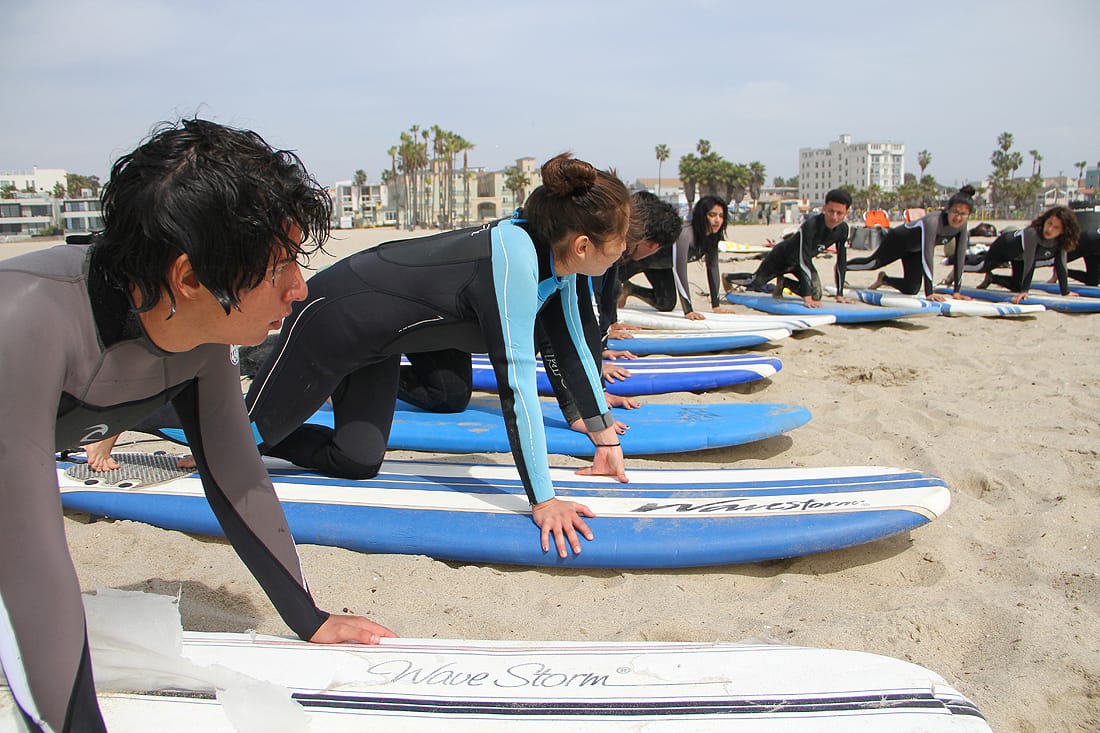
SM BEACH — Santa Monica's summer is in full swing, and with it come millions of people in search of thrills on its idyllic beaches and gentle ocean waves.
But locals and visitors be warned: There are pirates in these waters.
Before anyone calls in the cavalry, the term "pirate" in this instance refers to rogue surfing instructors, individuals that hawk lessons promising that their students will become the next big thing, or at least be able to stand up on a board.
While they may be able to make good on their claims, that doesn't mean they carry insurance, and they definitely don't have the go-ahead from City Hall to populate the beaches and waters with longboard neophytes.
Licensed surf instructors who pay for the right to teach for a living bemoan the pirates' lack of overhead and their ability to teach larger classes — most instructors are limited to one-on-one classes, and can't reap the benefits of discount lessons and Groupon-like marketing techniques.
Some say that City Hall isn't doing enough to police the system, allowing the pirates to roam free at the beach with little response, even to direct complaints. There are fears that problem will only compound if regulations governing exercise instructors in public parks and on the beach come online, spreading resources thin.
Martin Squires, a surf instructor in Santa Monica, has played both sides of the game.
He operated as a "pirate" until he needed to expand the business, at which point Squires took his Kapowui surf school and secured a permit for both Santa Monica and Los Angeles County.
Kapowui means "pure joy," but Squires sounded less than joyful when he talked about the situation on the beach.
Illicit surf instructors dodge hundreds if not thousands of dollars that Squires himself paid out to make Kapowui legitimate, and some hire additional help to man stations in Los Angeles County and Santa Monica to maximize the profit potential of the two permits.
It causes tension, and sometimes confrontation if a pirate tries to jack a spot on the beach that Squires normally occupies.
"Surfing wasn't supposed to be like this," Squires said. "It was supposed to be fun and free."
Permitted surf instructors have to apply through a formal bidding process and compete for one of 10 individual surf instruction permits and two camps that can serve either 60 or 200 clients, depending on the location.
It's an arduous process that requires instructors have adequate insurance, background checks, and pay at least 15 percent of gross sales.
"It's a pretty extensive process. It's not like the old days when you could just show up and do a surf lesson," said Matt Rosas, a longtime surf instructor in Santa Monica.
The "old days" ended out of safety concerns, said Kathy LePrevost, community recreation manager with City Hall.
The permit system came into effect in the summer of 2008. Until that point, Santa Monica's beaches were open season, and it was causing safety issues that forced lifeguards to "blackball" sections of the beach, closing them for use, LePrevost said.
"It's had a tremendous impact by lessening the (amount) of surf instruction and improving the balance," LePrevost said.
Still, pirates abound, both in Santa Monica and other jurisdictions, surf instructors say, and it can be hard to tell who is who.
"I couldn't tell you who's supposed to be there and who shouldn't be there," said Marion Clark, owner of Surf Academy. "I know there's a lot of us teaching out there, and more than are permitted."
She doesn't feel comfortable policing the situation, and it can be a difficult task for authorities as well because lifeguards have to focus on water safety and city officials have miles of open beach to police..
"It's definitely a challenge when you're dealing with the open ocean," Rosas said.
Enforcement is a triple threat — the police department, city officials and Code Enforcement Division all work together along with Los Angeles County lifeguards to keep an eye on rogue instructors, but the beach is vast and even permit holders only have an identification card to display upon request.
Residents and visitors can do their part by doing a bit of research before jumping on a board.
People can find licensed surf instructors by going to the Community & Cultural Services Department website, clicking the "Places, Parks & Beach" tab at the top and then the "Santa Monica State Beach" tab on the left-hand side.
ashley@www.smdp.com

